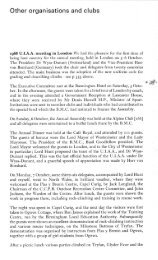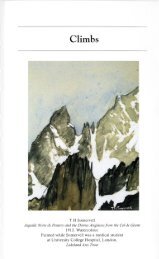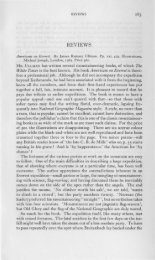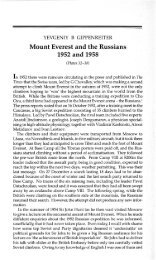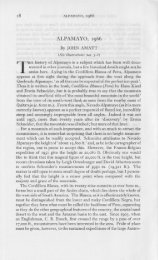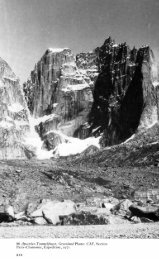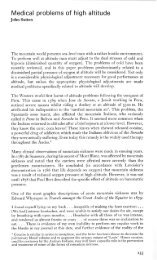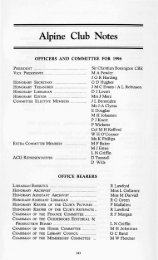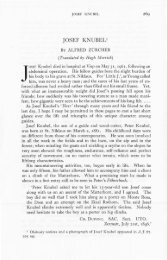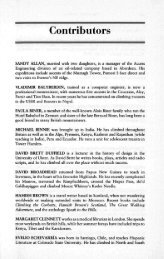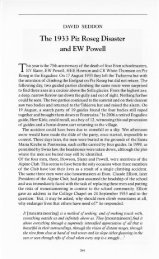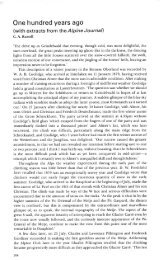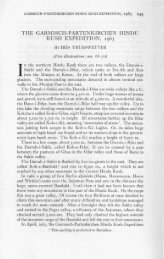AJ 2002 222-229 Ward Pundits.pdf - Alpine Journal
AJ 2002 222-229 Ward Pundits.pdf - Alpine Journal
AJ 2002 222-229 Ward Pundits.pdf - Alpine Journal
You also want an ePaper? Increase the reach of your titles
YUMPU automatically turns print PDFs into web optimized ePapers that Google loves.
THE PUNDITS AND THE PAMIR <strong>229</strong><br />
After a year's rest and debriefing, in 1875 the Mullah was asked to<br />
complete the survey of the Indus from its confluence with the Gilgit river<br />
to the plains. The primary aim of this journey was to obtain information<br />
about the tribes living adjacent to the river, who seldom left their valleys.<br />
After meeting a local man, Saeyed Amir, the Mullah travelled up the Indus<br />
valley, passing Nanga Parbat, and after reaching Gilgit he continued to<br />
Yasin. He then went west, returning to Peshawar on 1st October 1876. To<br />
allow suspicions about his true identity to die down, a year elapsed before<br />
he resumed his work, considered vital for an understanding of the geography<br />
of the region. In 1878 he was despatched in the guise of a timber merchant,<br />
but he was recognised by a ferryman who was thought to have murdered<br />
the Mullah's brother. Undeterred, he pressed on and acquired a large amount<br />
of information about the Swat valley. His survey linked with his own<br />
previous work and that of many others. However, the first comprehensive<br />
survey of the area was not finished until1895-97 following the defeat of a<br />
local uprising.<br />
The Mullah was described by the Surveyor General as 'the most<br />
painstaking and reliable of any of the Mussulman explorers that have been<br />
employed by the department'.<br />
As the Northwest Frontier region was penetrated more and more by<br />
British surveyors and military expeditions and by Russian surveyors north<br />
of the Oxus, the use of the pundits in this area became less important.<br />
However, the basic topography and intelligence about local people in this<br />
immensely complex region had been gathered by these three pundits, whose<br />
importance cannot be over-emphasised.<br />
From 1875 onwards, the efforts of the pundits were directed increasingly<br />
to the vast blank on the map of Central Asia, the Himalaya and Tibet.<br />
BIBLIOGRAPHY<br />
T E Gordon, The Roofofthe World. Edmonston and Douglas, 1876.<br />
This book contains many fascinating sketches of the region, drawn in<br />
the period when the three pundits mentioned were travelling in the area.<br />
Michael <strong>Ward</strong>, 'The Survey of India and the <strong>Pundits</strong>' in <strong>Alpine</strong> <strong>Journal</strong><br />
103,59-79,1998.<br />
Derek WaIler, The <strong>Pundits</strong>: British Exploration of Tibet and Central Asia.<br />
The University Press of Kentucky, 1990.<br />
T G Montgomerie, 'Report of the Mirza's exploration from Kabul to<br />
Kashgar' in <strong>Journal</strong> ofthe Royal Geographical Society 41,132-192, 187l.<br />
T G Montgomerie, 'A Havildar's Journey through Chitral to Faizabad in<br />
1870' in <strong>Journal</strong> ofthe Royal Geographical Society 42, 180-201, 1872.



